Freedom and Joy with Uma Kiwe
Mother Earth Liberation Process
“Freedom and Joy with Uma Kiwa” was collectively authored by Nasa indigenous people of Northern Cauca, Colombia, following the "Mother Earth Liberation Process" actions of 2015 and 2016. This movement, which has been active for almost twenty years now, practices the direct insurgent reclamation of ancestral lands and territories currently held by large sugar mills and major ethanol producers in Latin America. Translated for the first time into English, “Freedom and Joy” describes in vivid detail both the historical context and the autonomous practical methods by which the Nasa self-organize to expropriate and collectivize arable land, a direct struggle that pits them against agribusiness corporations, a neoliberal government, and paramilitary death squads. The text is preceded by a substantial new preface written especially for this edition, in which the authors describe the events leading from 2016 into the current moment.
Part of our ongoing series Weavings, which explores the new emancipatory tradition in Latin America.
Other languages: Español
Preface to the English edition (2023)
We speak here to the peoples, to the struggles in many parts of the world, to the English-speaking resistance to the system. We speak from northern Cauca, in what is today called Colombia. “Freedom and Joy with Uma Kiwe” in English? That’s quite something, especially when we take into account that English is the lingua franca of the empire, that is, one of the vehicles used to invade, colonize, exploit, and disconnect. Then again, the text originally came out in Spanish — the lingua franca of another empire — on December 16, 2016. By using the Spanish language as a vehicle to share our word, we reached many hearts around the world.
We will say it briefly: there are languages that are unable to communicate or connect with Uma Kiwe (Mother Earth) or the spiritual. They are secular languages for understanding ourselves between humans — that is their reach. Over the course of centuries, their spirit and essence were exhausted, and a husk is all that remains of them: just signs agreed upon by humans to understand a message. Of course, there are depths to these languages, profundities that connect feelings beyond discourse, as demonstrated by the many weavings of literary art.
Once they separate a language from Uma Kiwe, it becomes hollow. Such language can no longer communicate as it once did, when its umbilical cord was connected to Mother Earth. They separate it? Yes. The role of states, empires, and western science is to disconnect life and then plug it into cables, fibers, books, logos, programs, production, and television series. It is difficult to reconnect with Mother Earth when they’ve already left you befuddled. The treasure of languages that remain connected to Mother Earth must be cared for so that they do not disappear under the dominating pressure of the West. That is the struggle.
Maintaining this connection — the umbilical cord attached to Uma Kiwe — is what we have tried to do for the last nine years as the Mother Earth Liberation Process. For five centuries, the invaders, the conquistadores of these lands ripped apart all the weavings (the social fabric, community life, cultivations, spirituality). Those weavings are our books. Why is it so important to keep our umbilical cords attached to Mother Earth? It is life itself. It is everything that we are because everything that we are comes from Uma Kiwe and is written in our language. Water speaks to us. The mountains speak to us. The lagoons speak to us. The beings below the soil speak to us. The beings in the air above speak to us. They speak to us, nourish us, give us strength. Once that is broken, depression, sadness, boredom, suicide, and nonsense arrive, regardless of whether one lives in poverty or in wealth and abundance.
That’s why we are liberating Mother Earth. We use the word “liberate” because it is perhaps easier to understand. But the word that we use in our language is “sanar” [to heal], because Uma Kiwe is sick — sick with capitalism. We are not naïve: it is not “the humans” making the planet sick — it is the model of economy, development, relations, and corruption called capitalism that is making Uma Kiwe sick. Capitalism has given Uma Kiwe a fever, hurt its skin, and harmed its insides. That is why Uma Kiwe cannot be the Mother it has always been. That is why it is now shaken up by cyclones, hurricanes, earthquakes, droughts, and floods that did not occur before when her rhythms were harmonized in natural cycles.
Instead of saying that we are healing Uma Kiwe, we say that we are healing ourselves with our Mother because the virus of capitalism has invaded our heart. Capitalism makes you think differently and make strange decisions, like drawing blood from the Earth, which is petroleum; perforating the ice caps, the great cool blanket; destroying the green blanket, which is the Amazon jungle; placing walls in the rivers that keep the bocachico1 from returning home to continue sustaining life; splattering the sky with lights and sounds that disorient the birds on their long journeys; tearing down giant forests to plant soy, palm, and sugarcane plantations…
The sugarcane monoculture in the Cauca River valley is an enormous tumor on Uma Kiwe. Three hundred thousand hectares of tropical dry forests were deforested to plant sugarcane for the production of sugar and agrofuels. We decided one day to enter these plantations full of cane where our grandfathers and grandmothers once lived to heal Uma Kiwe and heal ourselves of capitalism by cutting down cane and planting food. Freedom and Joy with Uma Kiwe recounts how, when, where, who, with what, why, and for what this happened.
What has happened since we released “Freedom and Joy with Uma Kiwe”?
On September 2, 2005, some Nasa communities of northern Cauca circulated a call for the Liberation of Mother Earth, and we returned to the direct struggle for the land. This direct struggle had been halted for fifteen years due to the force of the 1991 Constitution, which made the struggle more institutional. At that moment, we made a tactical error and negotiated an agreement with Uribe’s government that cost us nine years. No longer believing in agreements, we decided to enter the plantations on December 14, 2014. Between then and 2023 we were able to eradicate 12,500 hectares of cane, which are now being reclaimed with vegetation and pastures, as well as communitarian and familial gardens (huertas). This number would grow if it weren’t for the deceit of the state, but the state always gets in the way to stop struggles and impose capitalist relations.
On our journey of healing ourselves with Uma Kiwe, we have been able to implement (caminar) our entire seven-point agenda, which is included at the end of Freedom and Joy with Uma Kiwe.
The most important thing we’ve done is hold hundreds of mingas2 to cut cane and plant food, to the point of reaching the 12,500 liberated hectares that we mentioned before. On these lands, we founded 27 towns or “liberation points” (puntos de liberación) where we built huts out of bamboo and plastic, planted communitarian and family gardens, and tended to chickens, turkeys, horses, cows, and pigs…
We also organized various journeys around northern Cauca, Colombia, and the world, sharing the following message of the Mother Earth Liberation Process: What if every corner of the planet was a liberation point?
We held two assemblies as the Mother Earth Liberation Process and hundreds of meetings at the liberation points to continue implementing (caminando) this agenda.
We organized a “communication minga,” which was a space for making a minga for the communicative labor of the Mother Earth Liberation Process. This included creating the Vamos al Corte radio program, using social media, and organizing encounters at the liberation points with video-forums and struggle-art (arte luchador).
We organized a political school for liberation to clear our heart and to reconnect all that empires and states have disconnected. The first part of this consisted of re-reading five centuries of our history of struggle against the various empires, allowing the violence and resistance to pass through our heart in order to continue walking in time as Nasa.
We held five “food marches” (marchas de la comida), which consisted of collecting harvests from liberated lands to donate them to local struggles in Colombia’s largest cities like Cali, Bogotá, Medellín, and Manizales. We sent more than 50 tons of food from the liberation points to communities resisting in urban areas.
We held three International Encounters of Liberators of Mother Earth at the liberation points, where we convened people from many struggles around the world to join forces and continue liberating Mother Earth.
When we succeeded in implementing that agenda in 2018, we went for more:
We continue implementing our seven-point agenda. We continue to liberate more plantations. That’s how we managed to reach twenty seven plantations and 12,500 hectares.
We organized the Kwesx Yuwe School of the Mother Earth Liberation Process to reconnect our umbilical cords with our own language, because many families lost the language due to colonial violence.
We organized Desalambrarte, a collective of people and artistic action in the territory, which uses art as a means of liberation struggle.
We organized mingas to reforest the water springs and protect the rivers and creeks that pass through the liberated lands.
We held a resistance market that sold harvests at just prices in a popular neighborhood in Cali without intermediaries that take the profits, and without the meddling of the state. It was a market organized as a peoples-to-peoples arrangement.
We organized Liberation Point Press (Editorial Punto de Liberación) to share our written word through books, pamphlets, and posters. Seven books have been published in Spanish, and they are being translated into other languages to print at our own press.
We were able to achieve all this while the sugarcane conglomerates, INCAUCA (the largest sugarcane refinery in Latin America and the largest producer of agrofuel in Colombia), and the Colombian state persecuted us politically, militarily, and judicially. We also received threats from paramilitary groups. To give you just a few tidbits of information, we’ll tell you that between 2014 and 2023 the Colombian state and private security guards of the sugarcane refineries murdered fourteen of our compañeros. Two more were murdered between 2005 and 2006 by the Colombian state. That means a total of sixteen of our compañeros have been murdered for liberating Mother Earth. There have been more than four hundred police and military operations to evict us from our farms, resulting in more than six hundred compañeros injured — but they have never succeeded in evicting us. Eight compañeros have been incarcerated, and there are reportedly more than a hundred arrest warrants out for people that belong to the Mother Earth Liberation Process.
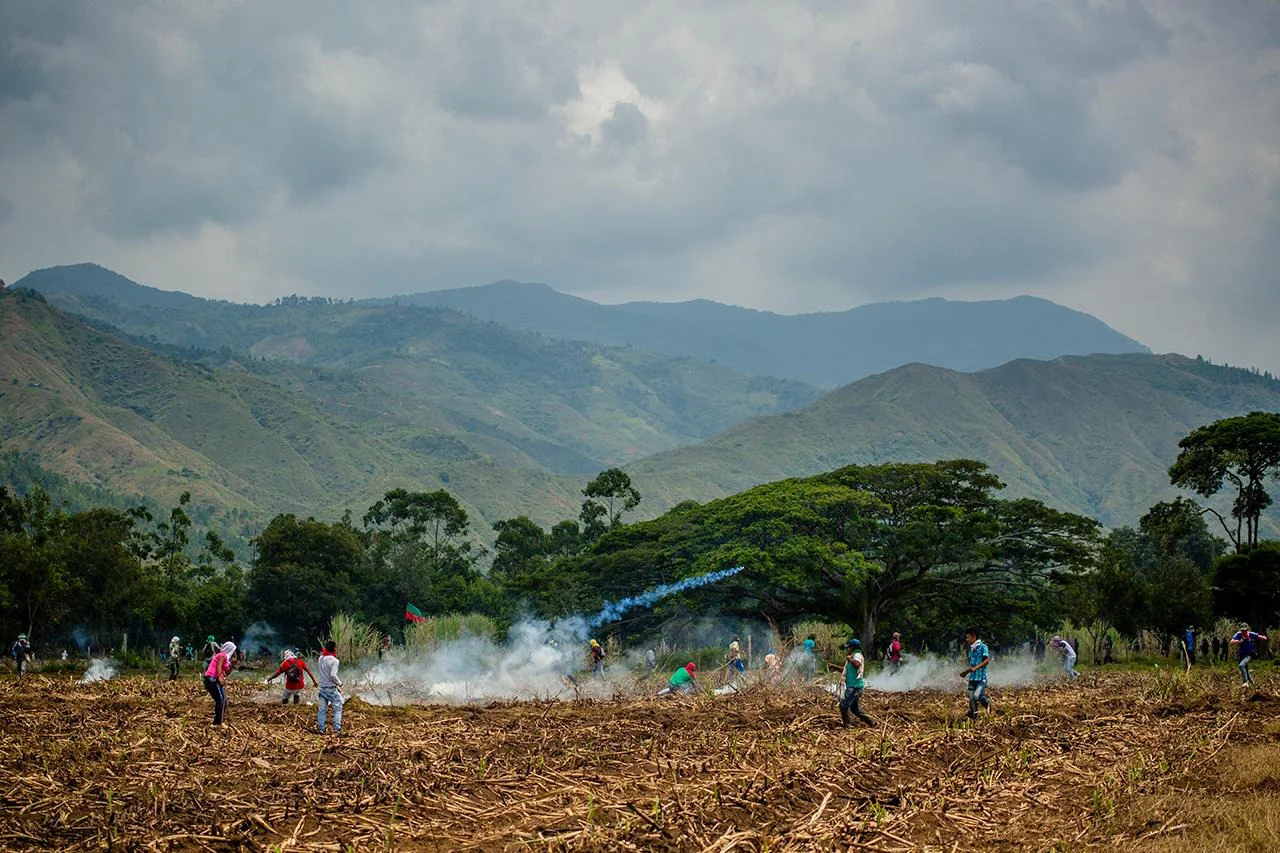
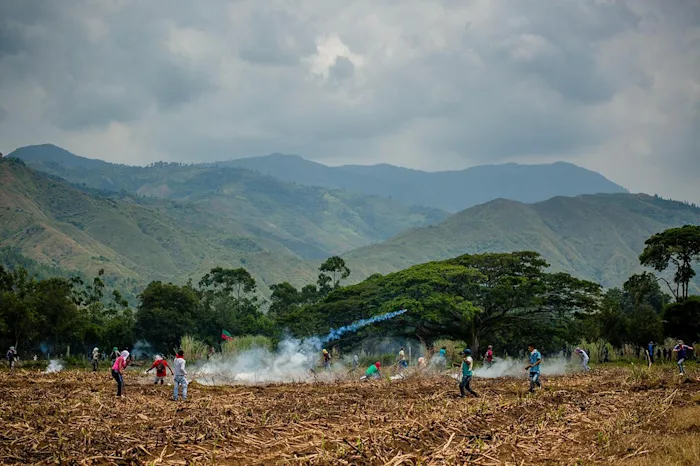
What has happened over the last year?
One month after its inauguration, the first “leftist” government of Colombia treated us as invaders (invasores) and gave us forty eight hours to abandon our farms, which we did not do. In that context, the sugarcane agroindustry sharpened its weapons, and some sugarcane refineries organized paramilitary groups in early 2023 to attack strategic liberation points. They incentivized sugarcane workers to stop the liberation, and financed actions in neighboring communities to generate conflict in order to stop the Mother Earth Liberation Process. The Colombian government started to implement its agrarian reform at the national level. In that context, it bought lands for Afrodescendant communities in northern Cauca that included two plantations: La Emperatriz and Canaima. These plantations were in the process of being liberated. They are plantations where two of our compañeros were murdered, where hundreds were injured, where some commoners (comuneros) were arrested, where dozens of arrest warrants were issued, where INCAUCA ordered the poisoning of eighteen cows of the liberation process. They are the plantations where the El Nilo massacre of 1991 was planned.
Since this government arrived, we have circulated a message that the agrarian reform should include the Afrodescendant and peasant communities of northern Cauca. At the same time, we have said that the Nasa families of the Liberation Process are responsible for our own “agrarian reform”: the 12,500 liberated hectares…nobody gave them to us, we did it ourselves. That’s why we’ve said that in the Cauca River valley there are roughly 400,000 hectares of sugarcane monoculture, more than enough land for an agrarian reform that does not affect what we’ve already achieved in our struggle.
Progressivism arrived with all its strength, as shown in other countries throughout the region. Petro’s government also promised that, in addition to buying lands, it would create development projects for the communities. The heart becomes confused. How do we maintain the connection — the umbilical cord attached to Uma Kiwe — in this context? Development projects are a big temptation, because they dwindle efforts and raise incomes. But developmentalism (desarrollismo) does not agree with Mother Earth — it distances us from the dream. We already said it: the role of the state is to disconnect.
While the struggles of the world may enjoy and suffer from this reading, we continue doing the work, maintaining the dream of liberating ourselves with Mother Earth in this corner where we live and struggle, untangling our hearts, reconnecting. This is just one of many moments in which capitalism finds ways to confuse our path, and — as in other times — we continue with our dream intact. Life cannot endure more big plantations of cane, palm, soy…in any territory of the world. It is necessary to eradicate those and other tumors on Mother Earth to continue to take care of one another and heal ourselves based on the language that connects us with the umbilical cord, to once again be joyful and free with Uma Kiwe.
—Mother Earth Liberation Process, Northern Cauca, November 2023.
The sun is setting. From the hill above, festival and funeral songs. Inside the coffin, a compañero. Birdsongs, voices of little animals in the bush, on the ground, under the ground. Faces with tears or laughter. Pain and rage in the heart. The bastones de mando clenched: rebellious, invincible.3 The Nasas will never be defeated. The living memory of thousands of years. And in it, a commitment:
We will not rest until we see Her free.
Amidst the singing, the laughter, the embraces, the sobbing, the voices, the contained rage, the rebellion pounding in our veins — in the middle of it all — his body returned to the bosom of Mother Earth. They shot him so that he would fall, but he died standing up. They shot him to silence him, to diminish him. The spirits do not sleep: from the top of the hill at El Pílamo, today he illuminates the path of the Nasa people.
Do you remember him? Guillermo Paví Ramos, Nasa Indian, 19-year-old young man, rebel, defiant, assassinated April 11, 2015 by the armed forces of the Colombian state. Which public force could that be? The private security of the owners of the world.
We are the land where his navel was sown
Who are we? We are the brothers, the sisters, the friends, the homies, the nephews and nieces, the community, the land where his navel was sown 20 years ago.4 We are the continuation of the struggle of Guillermo the Son and Guillermo the Father, who were also murdered; the family of the twenty people massacred at El Nilo: Darío, Ofelia, Carolina, Adán, Edgar, Otoniel, Mariana, Eleuterio, Tiberio, Floresmiro, Mario, María Jesús, Nicolás, Feliciano, Calixto, Julio, José Jairo, Jesús Albeiro, Daniel and Domingo; the kin of the thirteen people massacred at Gualanday — among them seven kiwe thegnas; the eight people massacred at San Pedro; the hundred people massacred in El Naya; and the five people massacred from López Adentro; the family of Cristóbal, of Marden, of Benjamín, of Álvaro Nasa Pal, murdered; the tribe of Anatolio; the descendants of the hundreds of men and women who fell freeing her, genocided; the sowing of Quintín Lame, of Juan Tama, of La Gaitana and her twenty thousand warriors who faced the first onslaught; the prolongation of the remote dance of Uma and Tay in which they met, fell in love, and became a couple.5
Tired of receiving beatings, insults, garbage, crumbs, we are the communities of the Nasa people who stood up to Goliath and hurled a stone at his forehead: Munchique, Huellas, López Adentro, and Corinto; based in the plantations of Quitapereza, Los Mangos, La Emperatriz, Canaima I, II and III, La Albania, Quebrada Seca, Miraflores, García Arriba, García Abajo, Caucana, Cultivos, Granadita, Vista Hermosa, San Luis Abajo, and those to come. Some belong to INCAUCA, others serve INCAUCA (the largest sugar refinery in Latin America, according to its owners).
We are communities of the Regional Indigenous Council of Cauca (CRIC), enacting its platform of struggle: to liberate the land, expand the territory, refuse to pay terraje.6 We returned to our land, now in the hands of the deputies of agribusiness and the global financial system. We are the communities in the process of liberating Mother Earth — Uma Kiwe — and we will not rest until we see Her free.
And we come — 25 years after the devastating blow of the massacre of twenty brothers and sisters at El Nilo and their sowing on that liberated land, and two years after reoccupying those plantations — to tell you where this liberation of Mother Earth was born, from whom, what for, how we are doing it, and what's next.
A little bit of history
She was young and crying in the middle of a party. A party in December. It was the second party we celebrated in a village of the liberation. After a while, we knew why she was crying. The village — located in a bend of the ravine of the Miraflores sugarcane plantation — was filled with music, food, chicha, people, dogs. We ate, we drank, we danced, and we said happy new year.
The lands we occupy today, the plantations in the process of liberation, are ours. We are here because they are ours. Otherwise, we would not be here. Who do you think we are? Of course, the deeds are in the name of other owners, and that is the confusing part.
Many years ago, these valleys were the land and home of our people, who inhabited this region in the southwest of what is today referred to as Colombia. They lived well, eating, drinking, chewing, offering, weaving, dancing... One day, in 1535, came the Conquest. One night we went to bed Nasa, and the next morning woke up “Indians.” The exploitation of our land had begun, and it became a theater of operations. Since then, we have known neither peace nor rest.
Three years later, once the conquistadors had shown their teeth, a very womanly woman, La Gaitana, could not stand it any longer and took up arms to defend the land. She organized an army of 20,000 Nasas, Yalcones, Pijaos, and Timanaes guards to defend the honor and the land of our peoples — the same land we now walk on, the same land we have now returned to. The war of resistance that she began lasted 120 years, perhaps the longest that any people have fought in history. The resistance she initiated is 478 years old. Without peace or rest.
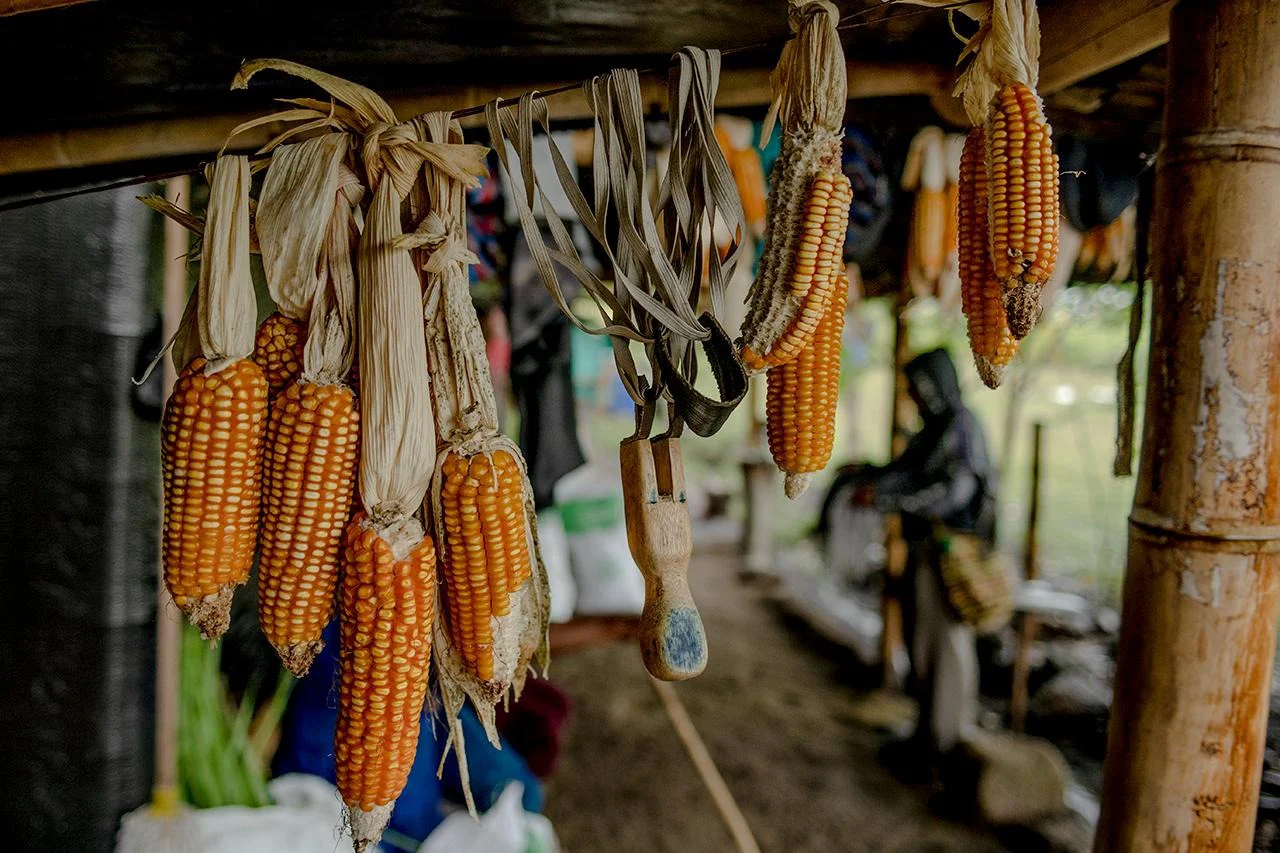
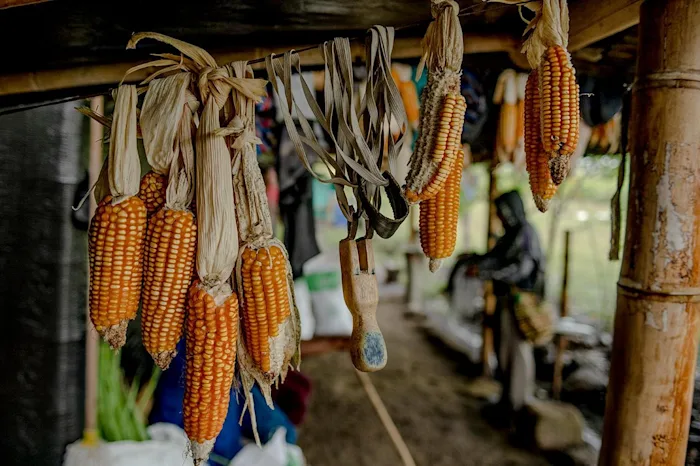
We stopped the war. Not because the dream of defending the Earth had died, but because there was a change of strategy. By the end of the war, our lives had changed forever. Many peoples united and formed our current Nasa nation. Around the year 1700, the chiefs Juan Tama and Manuel de Quilo y Sicos reached an agreement with the Spanish empire. Since then we have lived tightly packed into territories called resguardos (reservations) — but alive and together. The Nasas will never be defeated, declared Juan Tama. Later in the nineteenth century, the resguardos were invaded by the newly founded Colombia, and we became terrajeros, slaves of landowners. At the beginning of the twentieth century, we rose up again under the aegis of Quintín Lame and with the law under our arms. In the middle of the century, the war that bled Colombia dry (La Violencia) displaced us from our lands, and we reached regions like El Naya, from which we were once again displaced 50 years later. The fact is that, in the memory of Quintín, chopping and sowing, we took back the land before and after 1971. Land for the people. Some 120,000 hectares in Cauca.
By the force of memory and rebellion, free men and women sprouted again from wombs in our territories. Freedom comes with the land. Listening to the Nasa Pal7, we organized ourselves through life plans (planes de vida) in which critical conscience helped us to illuminate the path to come, which was very dark indeed. People for the land.
We were no longer terrajeros, no longer slaves at the service of a landowner. This much, we achieved… that is, until the world changed, and neoliberalism was shoved up our noses. In 1991, we were welcomed to the future with a political pact, the second since colonial times. This was sealed in the Political Constitution of that year and with the massacre of our twenty brothers and sisters on December 16 whose names open this writing. Our welcoming to the future was as follows: neoliberalism would come to vanquish us once and for all. Now it is clear: it was a political pact in which they won. Meanwhile, we had to be content with the corner that they assigned to us with the crumbs of a state that little by little would be handed over to the owners of the world. With the Massacre of the Twenty, they warned us about how life would be from then on. A return to terraje: surrender or die. And the long resistance of the Gaitana, the political skill of Juan Tama and Manuel de Quilo y Sicos, the uprising of Quintín, the life plans…where were they? In neither of the two options. We are alive because we did not surrender.
The strength of our life plans allowed us to take long strides towards autonomy. We were even able to propose an alternative that mobilized and inspired a whole country. At around the same time, we demanded that another world was “possible and necessary” (2004); stopped the trade agreement with the United States, the FTA (2005); stood up for the Freedom of Mother Earth (2005); visited various regions of Colombia to relate what we want and to listen (2007); and visited them again a year later to recover the dignity of the peoples without owners. But that time passed quickly. All of that was dismantled, and — since then — two agendas have been advancing: the institutional and the communitarian.
Here we continue our plan with the twenty brothers and sisters who lead it. They go forward raising a green and red flag. Do you see them? We know how to walk because there are compañeros and compañeras who walk ahead of us. And the dream remains intact: to free the Earth from the power that invaded us one day in 1535 — a power that has now become more sophisticated — to live with her, dancing, drinking, eating, chewing, offering, weaving with all the peoples of the world, with all living beings. That was life before the Conquest, and that will be life again someday.
It is already going that way. The Constitution of 1991 would not dazzle us forever. We rubbed our eyes and — as we said — we rose up for the liberation of Mother Earth by entering La Emperatriz on September 2, 2005, after 14 years of lethargy. This plantation is emblematic because the military operation that took the Twenty from us was planned and launched from there. Eleven days later, we wrangled the government into signing an agreement for twenty billion pesos for the purchase of land. But they are two-faced rascals, smooth-talkers, and cheats. They failed to comply, as they have failed to comply with 1,200 other agreements, according to some accounts. With the Nasa people, for example, they have failed to comply with dozens of agreements regarding the reparation for the massacre of the Twenty, which happened twenty five years ago.
We waited, we learned, we returned.
A dog does not get castrated twice. On December 14, 2014, a group of commoners (comuneros and comuneras) — with no title other than 476 years of fierce experiences and thousands of years of wild memory — entered four plantations. Two of the plantations belonged to INCAUCA, which belongs to the tycoon that appears in a few lines of Forbes, the magazine where the richest people in the world appear, that is, those who are the greatest dispossessors.
And that is how we arrived at this crossroads of history: Tired of receiving beatings, insults, garbage, crumbs, we are the communities of the Nasa people who stood up to Goliath and threw a stone at his forehead. For the first time since the Conquest, we went on the offensive. And with a slingshot of our own making.
Armed struggle; agreements and maneuvering; taking advantage of the state’s laws; uprisings; organization based on critical consciousness; and coming together for another possible and necessary world are the strategies that have sustained us. They are the word that nourishes us. We have learned a lot from all of these strategies. Because of them, we continue to say “presente” in the book of life. Other peoples say “presente” in books made of paper. Now, after so much walking and learning, we resort to memory and rebellion more than ever. It is clear that the step we are taking at this crossroads opens a new stage for us as a people. For the same reason, we are going to submerge ourselves more and more in our ancestral memory, in our original wisdom, in the word — all of which guarantee us what we are looking for. The Nasa word, which has waited so long to speak, now raises its hand, without letting go of the sling, and says: “Rebellion? Revolution? Reform? We’re about wët wët fxi'zenxi.”8
Surely you are wondering: what happened to all that land that used to be “ours”? Who does it belong to now? If they cornered us onto the mountain cliffs, what happened to the rest of it? The answer is simple: it belongs to the world system, the global chain of production. To the big landowners. To a snobby industrialist who managed to snatch a spot in Forbes and owns the media companies through which he preaches — but does not practice — love for his neighbor.

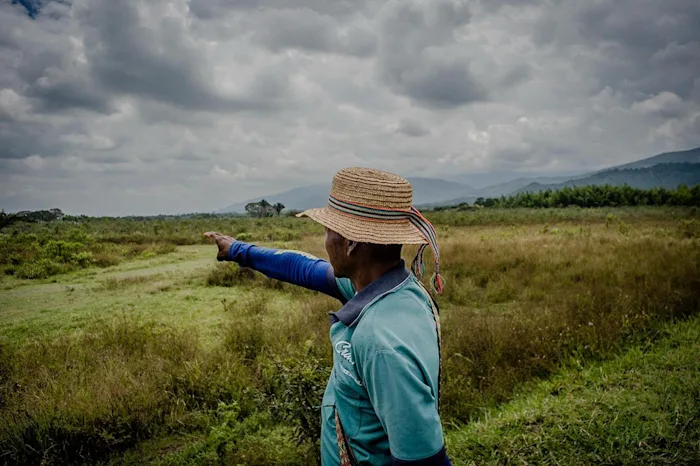
Here’s a fact: these lands will be our home in a matter of time. Why? Because they are ours; because we have been after them for three decades; because they planned the Naya massacre at La Emperatriz and the assassins of the Twenty left from there; because we have spilled Nasa blood on those lands and where Nasa blood falls, there goes the boundary stone; because if the ecosystems of the valley and the mountains are not restored, we are toast — that is, without them we cannot reach wët wët fxi'zenxi. The blood of the first warriors runs through our veins, the same blood of the caciques who founded our modernity, the same blood of Quintín and those who rose up with him, the same blood of all those who have continued to die in the struggle to see Her in freedom. And you see how life is: the same blood of a young girl who cries at a party in December.
That December night, Julia remembered her father, who was killed by the guerrillas when she was a child. Now she is kiwe thegna. She met her partner in the Indigenous Guard, got pregnant, had her son, to whom she will give the staff (bastón) that her partner gave her. "In the guard I will die, I never plan to leave," she said, and smiled for the first time that night.
Land in Colombia: let the numbers speak
While we are on the subject, let's get into it. How much land do we have? Who does the land belong to in Colombia? Let's stick with some data, because a deeper and more detailed study will come in time. Let's see if we can understand where these numbers come from, and why there are racist comments saying that “we have too much land, yet still we want more.” And why it is that we say that the land is held in just a few hands, that it is enslaved (and more). The numbers have something to say. And it requires patience because these words weigh more than a bundle of firewood.
We are going to rely on data from official and academic studies, as well as a scientific calculator, to avoid malicious glares. We already collected some data in the book Seguimos en Minga por la libertad de la Madre Tierra (We Remain in Minga for the Freedom of Mother Earth). It is a tremendous book, we recommend it.
Let's go to Colombia:
Colombia has turned over five million hectares of land to mining concessions. 25 million hectares will end up getting entangled in this because they are being solicited as mining concessions. The lands intended for mining include our territories. The land dedicated to mining is no longer ours because it serves other bosses, and the profits are all going elsewhere. So, the land is enslaved and dismembered.
In Colombia, 0.4% of owners own 41.1% of the land (according to the last agrarian census). Cattle ranchers own 45 million hectares. There are 24 million cows in Colombia. One cow has two hectares. Each cow produces about 800 liters of methane gas every day. This gas gives Uma Kiwe a fever. So, the land is sick.
In Colombia there are thirty six páramos (high altitude ecosystems found in the Andes), and the government granted environmental licenses to allow mining in twenty six of them. Later, the Constitutional Court put its foot down on the government. And the communities should do the same: the páramos are part of the ecological balance. If they are damaged, the water cycle is altered, the spirits become angered, and the subtle balance that sustains everything that exists is damaged.
Violence displaced people from more than 6.5 million hectares over the last twenty years. The harvest of paramilitary violence was land that was later converted into monocultures for crops like oil palm. The UN registers Colombia as the country with the most displaced people in the world. The dispossession of land was done through a war that displaced seven million people from the countryside. The rich people of this country are so insolent that they celebrate the pain and take advantage of this dispossession while saying that we stole their land: they accuse us in order to hide themselves. Much of the land that currently belongs to the sugar mills was taken during La Violencia, which also provided cheap labor for business. Another part of that land was part of a bloody inheritance from the conquering and colonizing families. Stolen land. Enslaved and tortured land.
Seventy percent of the food we eat in Colombia comes from small landowners. Of course, the big landowners use the land for monocultures of sugarcane, soy, oil palm, and extensive cattle raising. Cows have more land than people: two hectares per cow.
Colombian agriculture has been abandoned to make way for Mining Colombia (Colombia Minera). The ZIDRES law seeks to hand over the land of the landless (the nation's “unused lands” or baldíos) to foreign investors, or to hand over land to peasants who voluntarily want to become pawns of businessmen who know how to exploit land and people (by becoming "associated" with them). And that is not the way.
Let’s go to Cauca:
We have 1,300,000 inhabitants. There are 3,000,000 hectares. 85.4% of landowners in Cauca have 26.03% of the land in small plots of land. 7.8% of landowners own 60.22% of the land, more than half of Cauca's land. 0.52% of the landowners own 15.63% of the land. The Chaux family, as well as the Valencias, the Iragorris, and the Arboledas have been the “owners” of haciendas on the land of Cauca's resguardos.
According to this data, taken from a study conducted by IGAC (a state entity), a person from the landowners' club owns — on average — 890 hectares in Cauca. How shameless: they have land and want more.
In the case of Cauca, Indian land comprises 612,000 hectares. The Society of Farmers and Cattle Ranchers (SAG) of Cauca — that is, the landowners' club — reveals the numbers that suit them. They say that we have a quarter of Cauca. Again, we must look deeper: A study by the Javeriana University says this about that land:
252,000 hectares are for plants and animals (forestry vocation); 75,000 hectares are páramos; 25,000 hectares are unproductive lands; 91,000 hectares are suitable for cultivation; 260,000 of us are Indians of Cauca.
Let's do the math:
91,000 hectares divided by 260,000 people gives 0.37. 91,000 ÷ 260,000 = 0.37: one small piece of a hectare per person.
So, in reality, in Cauca, we only have 91,000 hectares in total, and one little piece per person. This is the land that feeds the Cauca, even though it is land of low fertility. The rest of “our” land serves the equilibrium of the entire planet: jungle, forest, páramos: water, air, biodiversity.
Let's go to northern Cauca:
The communities of the Nasa people of northern Cauca include 111,642 inhabitants grouped in 24,119 families in twenty indigenous territories. If we are talking about land, we have 206,288 hectares. Of this land, 82% (169,156 hectares) allows for the growth of the bush and animals. Only 18% (37,132 hectares) is suitable for agricultural activities. Since we live cornered against the mountain cliffs, we are forced to strike Mother Earth near springs, watersheds, páramos, and sacred sites. The lack of land is a headache for Uma Kiwe. Translation: poor access to land disturbs ecosystems and generates multiple crises on planet Earth.
Most of the flat land in northern Cauca is planted with sugarcane, some 250,000 hectares in the region, for sugar and agrofuel production. The sugar mills consume 25 million liters of water per second, taken from rivers, streams, and 2,000 deep wells.
In spite of how tight it is on the small amount of land we have, we take care of 26,200 springs and 123 natural lagoons. The markets in the towns of northern Cauca are supplied with Indian food, as well as peasant and Afro-Caucan food (communities that are also cornered in small patches of land). The water from the aqueducts of the northern Cauca is planted and protected in the higher parts of the Indian territories, which are increasingly vulnerable.
Now let’s do the math, let’s get some averages:
37,132 hectares divided by 111,642 inhabitants, gives: 0.33 hectares per person. That is, one third of a hectare. 37,132 ÷ 111,642 = 0.33: one small piece of a hectare per person.
Now let’s look at other figures. The most current studies say that in Cauca, the family agricultural unit (unidad agrícola familiar, UAF) — the minimum amount of land that a family must have to sustain itself — should be 13 hectares (some studies recommend 20 hectares as the minimum size for a plot in Cauca).
Let's work with the low number — 13 hectares per family — and let's do the math: 24,119 families x 13 hectares = 313,547 total hectares. That's what we need to sustain the life plan (plan de vida).
Now: 313,547 hectares - 37,132 suitable for agricultural activities that we already have = 276,415 hectares. This is the land we need so that people, animals, plants, microorganisms and spirits can coexist peacefully. If not, how?
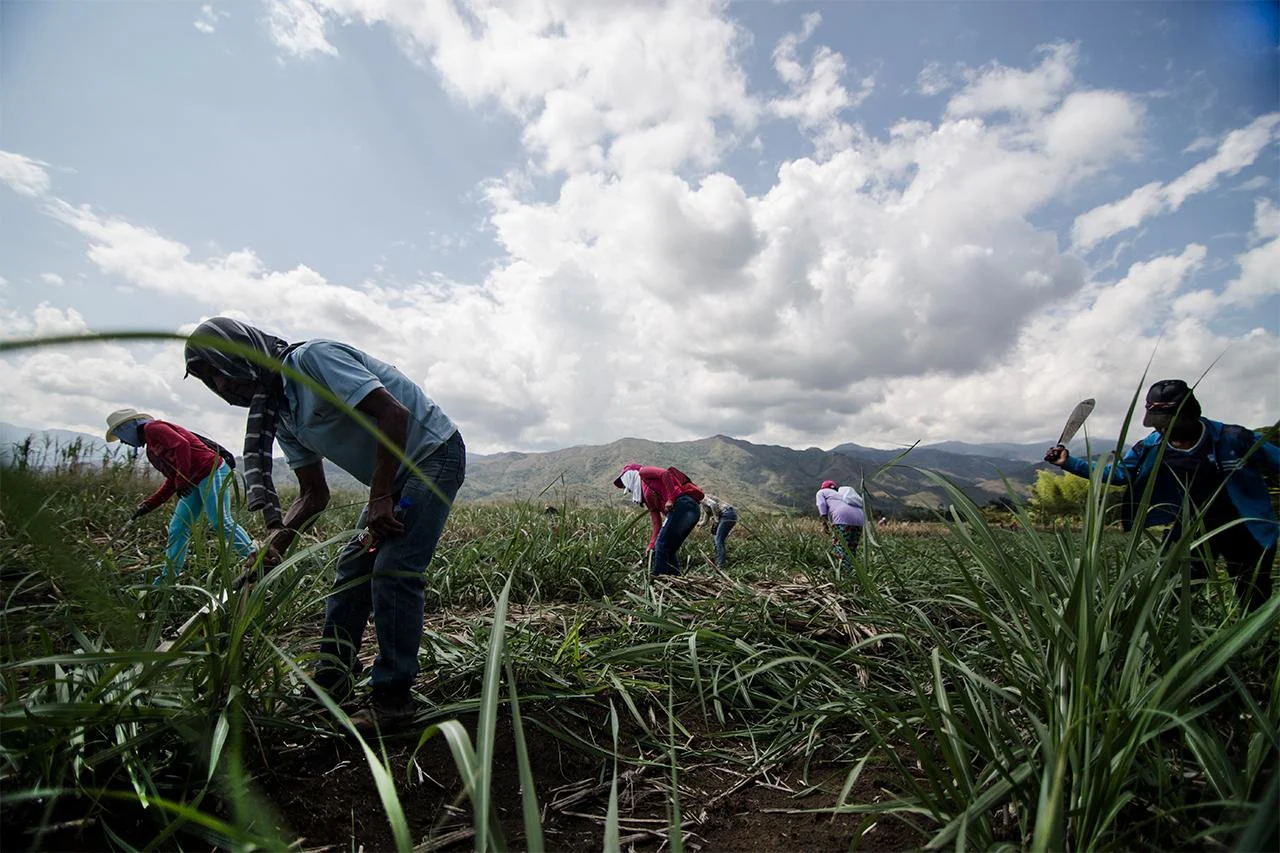
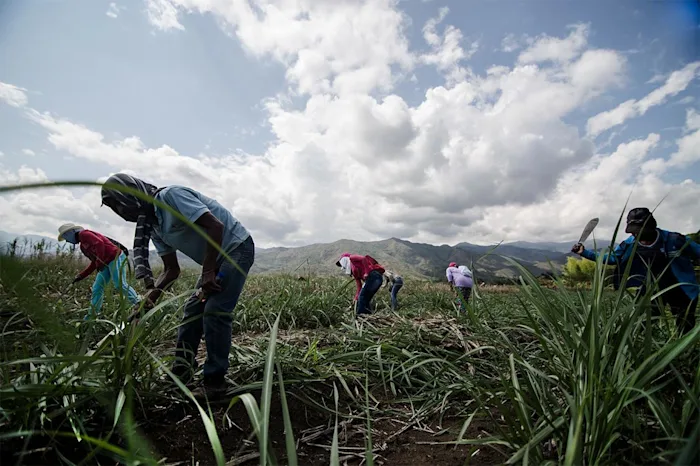
How much land do the peasant and Afro communities of the northern part of the Cauca need? We think that the land should be for all peoples, and the struggle to liberate it should be shared.
Let’s leave behind the tiresome repetition of numbers, and offer a couple of reflections.
It should be clear who monopolizes the land in Colombia, and we have said something about how they got hold of it, i.e., by theft. They stole it. From this land, they created enslaved people, and they created wealth at the expense of these people and the land. This is not new; this comes from long ago.
As the jungle and the mountains were being destroyed, so were the animals. The few that survive were displaced, and today they live frightened in small corners of the forest. In the Cauca River valley, almost the entirety of the forest and animals were eliminated to make way for extensive sugar cane plantations. An ecocide. For this ecosystem to recover its health, it must once again be populated by plants and animals. They are the ones who yearn the most for Uma Kiwe's freedom.
We know who is doing the stealing, we know who is exterminating through enslavement and torture. The problem does not only concern the exploitation of the land and the enslaved conditions of people (the word “slavery” is already an understatement), it is about their murder by torture and dismemberment. Not only do they administer human pain drop by drop, they also do mete out pain upon the Earth.
From Colombia, the capitalist club uproots the trees from the forests and jungles; invades the páramos and intends to subject them to mining; shrinks, disappears, and poisons rivers; sucks the water from the waterways that remain for monoculture and mining; poisons the soil and the air; fills the countryside and cities with garbage. This imbalance generates crazy winters and frightening droughts. Cities have become places where glass and plastic garbage is confused with the garbage of flesh and blood, that is, with the people who are left over because they have nothing to buy, and who cannot even be recycled like the other forms of garbage but are simply excess. In Popayán, beggars roam all over Caldas Park, the governor's office, the Cathedral. They are expelled from Bogotá for sullying its image, and they are spread all over Colombia. Shine a light on the face of a beggar. Shine a light on the face of the jaguar. Shine a light on a tree of the Pacific coast, shine a light on the face of a Wayú child... The Earth cries out that it cannot take any more.
Does capitalism listen? Do its spokesmen in Colombia feel pain? That is what one of them told us recently: that “what is happening hurts them.” We do not believe them.
They listen and celebrate. They enjoy the pain they cause. They toast, and continue making plans. In addition to what has already been shown, capitalism has made a wager on Cauca. Here’s a few examples:
From the Bota Caucana to Caldas Park, 500,000 hectares — a quarter of the department — is being explored for oil. They are also exploring the marine platform, and do not even respect the whales that come to enjoy the wonders of life in this corner of the Pacific.
On the Cauca coast, a deep-water port is projected to be the most important on the Pacific coast.
Two large highways of a megaproject (IIRSA) will be built in the center of Cauca.
Metal prospectors have titles and exploration rights in twenty five municipalities in the department, an area of some 900,000 hectares. In northern Cauca, there are 89 applications for exploration.
How we see things today
Goliath has not fallen. He is still standing. He is barely wobbling. The surprise of the attack has left him numb. In the silence and stillness, he chews on his infinite hatred, the trauma of what will come as revenge and reprimand. “Let them split Cauca in two,” said one of his spokeswomen, “one for the Indians and the other for the good guys.” “Let them do away with the Indians, the great hindrance,” many say.
This Goliath is one and many at the same time. It is INCAUCA and the rest of the sugar mills, it is the establishment, the economic and political power of Colombia; it is the military and paramilitary apparatus; it is the Colombian and world financial system. It is patriarchal society. All the same, all seeking to establish the single thought that today crushes the world. It comes from the first attack, the Conquest. Our fight is still against the conquerors of our lands. Goliath is still standing and will defend himself like a wounded animal. Because he is wounded. And with hatred, and with contempt and disgust for us.
The power that conquered us continues to conquer us. Terraje is not over. Now all the peoples are terrajeros in a new modality: day laborers, wage slaves of bosses we do not see, bosses who hide behind glass offices in faraway places protected by technological shields and security rings of the world military apparatus from where they fatten their profits.
They dominate, enslave, and torture the Earth and its people. They administer pain. They divvy up territories, lock up and program production, distribute portions of the population according to their needs, as if they were desserts at their banquets. What is left over, is left over. “The hydra that controls everything,” as the Zapatista family says. It creates wars to displace, frighten, control, and steal. The storm. The theater of operations on a global scale. The war against Uma Kiwe in its final offensive:
They come to scrape the pot. And what is left at the bottom of the big pot is not negligible: gold, oil, many minerals, gas, water, oxygen, biodiversity. There’s a lot, but that’s the last of it. There is so much that it makes them salivate...because of greed. There is so much that it will burst their bank accounts. But it is the last of it. It's either their bank accounts or life. It is either fulfilling the pleasure of their greed or life as we know it. Well, know that Mother Earth is not going to put up with that thrashing.
In Colombia it is clear: they are coming to party in peace, as the old redheaded man said. It is the beginning of a new stage of violence. Now they are declaring war on the environment, says the man.
This system has been cornering us and grabbing us by the throat with all its power and tricks. It is not content with turning us back into day laborers-terrajeros-slaves. Now, it exploits us to the extreme. Cornered between the cane and the páramo, between the valley and the mountain, subjected to forms of reduction, squeezed in our own land, it forces us to take sides, to find solutions quickly and easily. It happens here, there, and everywhere. Northern Cauca is just a sample of the world.
In this stranglehold, some have sought solace, a better place, a more comfortable area in which to spend the rest of their lives, tasting the few drops of honey that fall from the boss's table. "You have to be strategic. You have to take advantage of those resources", they say. “Smooth talkers” (boquisabrosos), said a Nasa elder.
In this context, at this crossroads of history, there is a regrouping, a rearrangement of forces and movements. The tectonic plates are shaking and there are earthquakes. In the midst of the storm, in the midst of the stranglehold to which we have been subjected, the organized people, the movements take position.
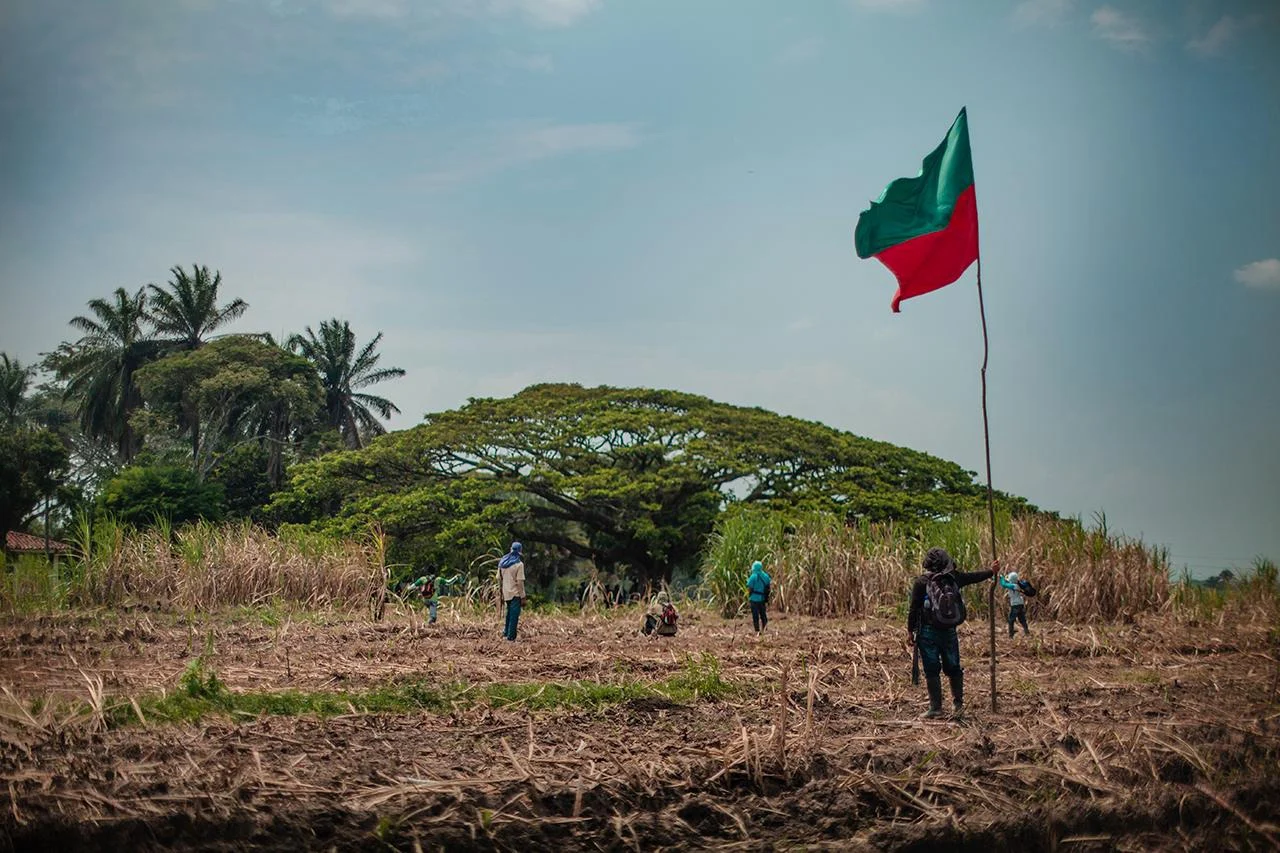
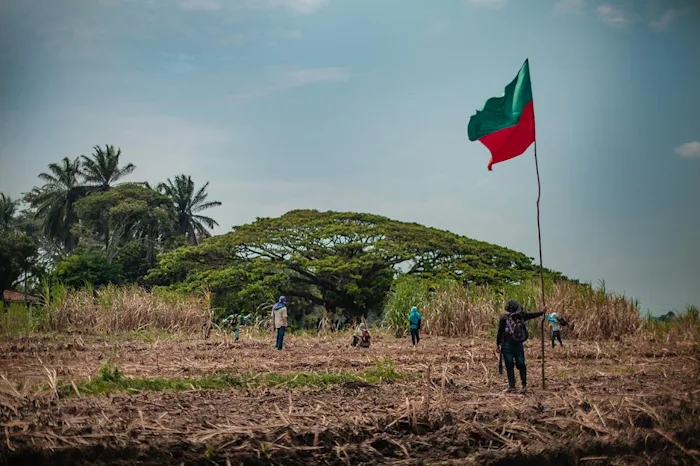
Some want to take over the state by electoral means. But progressivism reached its peak and is coming down. And if they made a pact with the bosses to hand over people and territories amid the storm, why would it go any other way?
Other movements that could not take power made a treaty with the State premised on its recognition of their rights, which are more like crumbs or drops of honey. The result of that love affair — full of courtship and candies — is the institutionalization of our movements. Better yet, it puts the tradition of struggle to sleep. Many movements gave up and married the state. They became what we have always fought head-on. While employing the disguises and discourse of struggle, they made a nest for themselves within capitalism.
But there is an offensive from below. Many peoples, communities, and groups have taken initiative. They organize themselves, take over factories, plantations, and highways, liberate territories, bring down laws through struggle, found caracoles9, confront the electoral monster to strip it naked, confront powerful armies and defeat them, stop dark destructive snakes, plant thousands of plots of healthy food, protect seeds, open alternative schools, protect forests, defend the water, liberate the airwaves and the internet.... The offensive from below disconcerts the offensive from above.
That is when we appear on the scene. The Liberation of Mother Earth is not a nest within the state or within capitalism. We liberate the Earth from capitalism — we liberate ourselves — to return to the time when we simply enjoyed our lives to the rhythm of Uma Kiwe by eating, drinking, dancing, weaving, and making offerings. We are a nest in the path of Mother Earth.
From the corner of history where we have been squeezed, we jump to the center and rise against economic, political, and military world powers. Ours is a purely natural act, like the bellicose actions of La Gaitana and her warriors. It flows from an understanding of the world context that leaves us no other option. For life, we risk our lives. For all beings to be, we risk our being.
How we are doing it
A young Nasa woman walked ahead swinging her hips. Blue jeans, black top with green stripes, black rubber boots, black hair pulled back in a bun inside her cap. You didn't have to have laser eyes to recognize her charm. We had just finished cutting cane under the hot sun, with sweat dripping all over our bodies, and we were looking for water amidst the sugarcane. When she turned to look, the locus of her charms shifted to the two dimples of her cheeks. When she opened her mouth, her soul was completely revealed: “My son has not woken up, because my tits do not itch.”
Our life in liberation is a feast. It consists of the simple act of cutting sugarcane to plant food. We also have time to play, to watch and admire, to make fun of those who cut badly, those who cut too slowly, those who cut too fast. Those who go out with a big pacora10 that weighs heavily just from carrying it,...“but the weight is what cuts, compañero”; those who go out with a small machete that is hardly good for chopping onions…“but that is something, compañera.”
Since we entered the plantations, we have cut down many of the thousands of monocultured hectares of sugarcane planted in northern Cauca to produce sugar and fuel. Sugar that sweetens soft drinks made from the water that comes down from our mountains. Fuel that moves cars that commercialize the soft drinks and make a lot of money. Money that finances war, the battalions that are still present in our territory and continue to threaten and kill us. The circle that enslaves Uma Kiwe.
We have planted many hectares of food: corn, beans, cassava, plantain, pumpkin. We wait for the owner to prepare the land, and then we start planting. We harvested some of it. The vast majority of the crops about to be harvested were destroyed in gigantic operations, typically in an Avatar-style theater of operations combining forces on the ground (army, police, tanks, riot police — ESMAD — and destructive machinery), and forces in the air (military helicopters). It is incredible that an ear of corn generates so much fear in high places. Once again, they damage our crops, once again we cry, and once again we go back to cutting and sowing. We are not in a rush, and we are not afraid.
We made envueltos de choclo and other delicacies from the food we have harvested, and ate them in front of the police. Imagine the psychological blow. We made chicha that we shared at festivities, like the one in December. Inside the plantations, we organized a minga (school) of communication over four-day meetings, and we danced until three in the morning while the armed forces were barricaded two hundred meters away. Psychological victories that are impossible to put into words.
In La Emperatriz, we celebrated forty five years of struggle of the Regional Indigenous Council of Cauca (CRIC) alongside 1,500 other people. Among many other things, we remembered that our platform of struggle speaks of recovering and expanding territory. And that for us, “peace” — a word we do not use — is land: freedom, equilibrium, harmony. That day, before the eyes of the world, next to the main road of the region, we founded a new village.
Yes, ladies and gentlemen: on the plantations in the process of liberation, we have founded villages with kitchens, earth latrines, swimming pools, meeting places, tulpas for our sacred ceremonies, and several huts. The liberation villages have been the site of meetings, games, trainings, artistic mingas, and the arrival of visitors from many parts of Colombia and the world who do not want to watch from the sidelines while David faces down Goliath.
We have waged heavy confrontations with riot police, and they have never defeated us. Despite all the weapons they have thanks to their support from the army, from private security outfits, and armed civilians, they had to build trenches or barricades in La Emperatriz, the only place in Colombia where they have had to resort to this system. From there, they fire bullets and teargas against people holding machetes, clubs, and slingshots. One of those bullets killed Guillermo Paví.
We have held meetings with peasant and Afro-descendant communities to debate and reach agreements. We have reached agreements, and we are doing joint mingas. We are going to get together and call on each other, join forces to liberate ourselves together. If there are receptive ears, we will continue walking. If not, we will continue walking anyway.
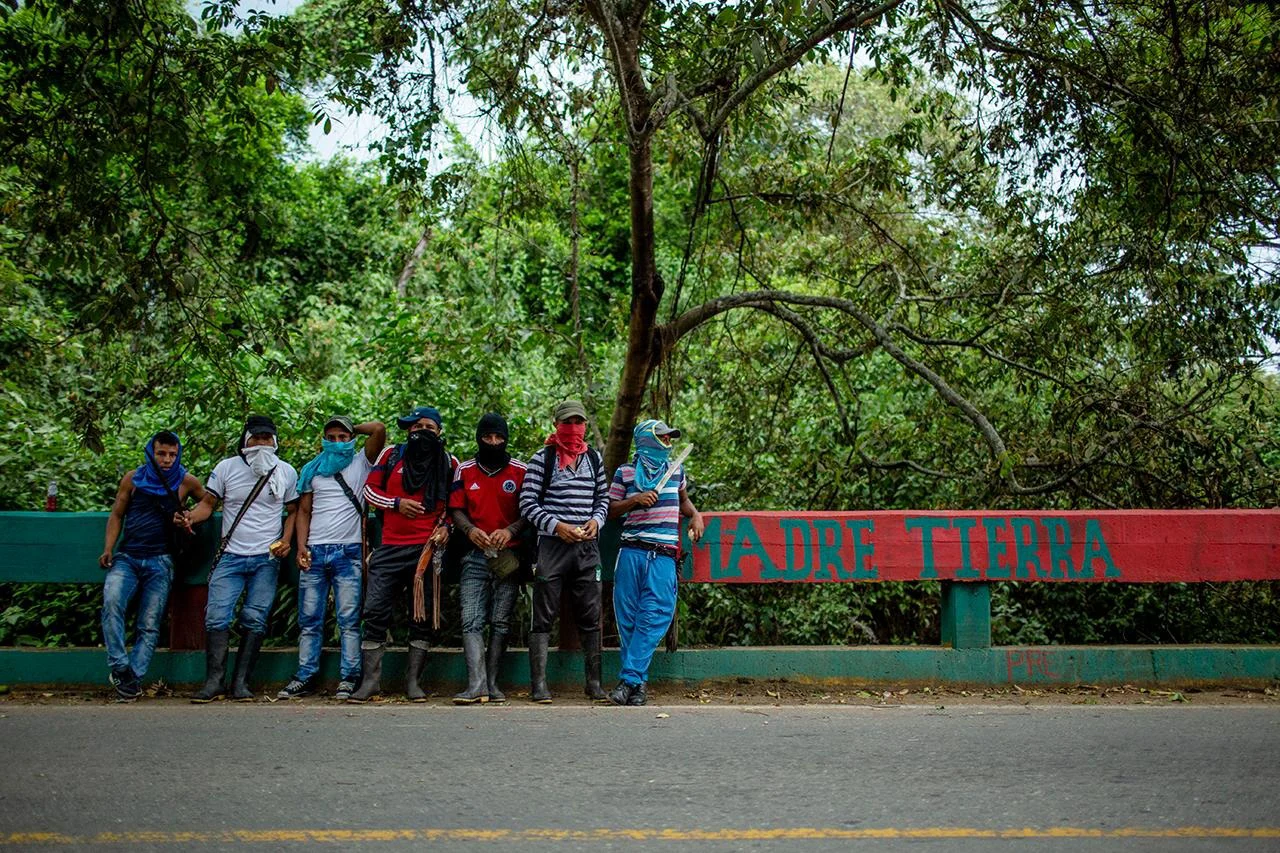
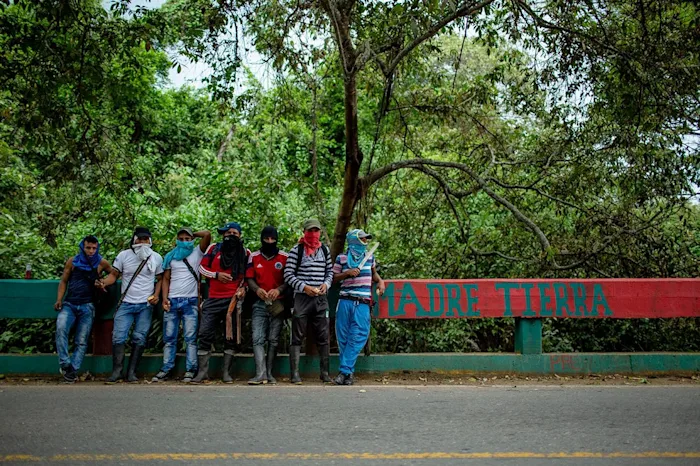
In Quitapereza, where the municipal government intends to build a regional garbage dump by expanding the current one, the community has resisted and is winning the fight. They have used lawsuits, a legal weapon, to stop the project until the prior consultation is carried out.
At 11:30 a.m., Milena scratches her breasts. “Lunch time, people.” We line up to receive beef sancocho while Milena goes into the shade to breastfeed her baby. We tell stories, laugh, eat lunch, keep laughing, make plans, and leave with a smile on our lips, with a sore arm, blistered hands, and fingers full of cane dust. Celebrating, with smiles on our cheeks. As we leave, we check to see how the corn we planted two months ago is doing: one more step towards liberation. We are bringing joy back to Mother Earth.
How power responds
In the middle of one of the many eviction attempts at the Empera, José felt the recalzada hit his body. Recalzadas are tear gas canisters filled with nails, glass balls, and pieces of metal. The ESMAD fires them with the truflai, their weapon for firing gas and now recalzadas. They aim at the chest, legs, face, wherever. Two Nasa compañeros were killed by recalzadas during the last mobilization in June. According to the official police report: “it wasn't us, they died from the impact of a handmade weapon.” José ran limping towards the place where the wounded were being treated, but he did not stop. They called his name, but he kept going towards his home with his face in pain and his body bleeding. Once at home, he laid face down on the bed and said to his compañera: “Babe, they shot me in the ass.”
Upon seeing the strength of the community, Goliath deploys strategies to stop the liberation of Mother Earth. The first thing he does is a media campaign to impair our gait, like they impaired José’s gait. Goliath circulates the claim that “we have a lot of land, but still we want more.” Our friend Freud calls this “projection” — that is, they blame us for what they are. They argue that they have legal titles and that we are land thieves. But we already saw above who is doing the stealing.
Afterwards, which can be minutes or days later, they carry out military operations as if they were in Desert Storm. They have made more than 200 attempts to evict us in vain. We have had more than 200 wounded, mutilated, three dead. Through immense operations they destroy crops about to be harvested. They have set up military or police bases on or near the plantations to repress the mingas. They have destroyed the villages and the sacred sites we have built on them. There are surveillance and intelligence operations near the liberation villages.
They spread racism through the media. Today being an Indian is the most despicable thing for society. “Those Indians,” “those who do not work,” “the state gives them everything, and still they ask for more.” Mayors like the mayor of Corinto and the mayor of Santander stir up a harmful and conflictual environment between communities. They send emissaries or middlemen to negotiate our withdrawal, while they plan evictions and fumigations with glyphosate, the new strategy. Monsanto-Bayer, far from being left out of the picture, offers us projects, “reasonable deals” for those willing to “talk like civilized people.” To which we reply: We are civilized people. That is why we liberate Mother Earth.
The legal strategy goes hand in glove with all of this. On the one hand, they pressure the owners not to offer the plantations for sale, while sowing the idea in public opinion that “not one more meter of land for the Indians.” They oppose the expansion of the resguardos (reservations). They promote conflict among indigenous peoples by offering to hand over plots of land in the plantations in the process of liberation (a game between a plantation owner and the mayor of Corinto). There are seventeen arrest warrants, ten compañeros have been prosecuted, among them indigenous governors.
For some time now, a private security group formed by a plantation owner and made up of workers and former guerrillas shoots at our mingas using short and long-range weapons, causing injuries in the community.
In recent months the paramilitary apparatus has moved into the region. They have already made several attempts to strike against the liberation process of Mother Earth.
So, Goliath is standing, shooting, and fuming. The community always says: we plan to stay here until we liberate Mother Earth.
What we are going to do
What we are going to do is to plant ourselves in a new time. This is the stage that the Nasa people have entered with the liberation of Mother Earth. It is the Earth that has called us to this time, and we have listened to her. When we say “new time,” we refer to an old time. Returning to the roots, little by little, to the deep wisdom of the Nasa people, which is the wisdom of the Earth. The future of planet Earth depends on the past. And as we have said: freeing the earth depends upon freeing the heart.11 Earth and heart: the same thing.
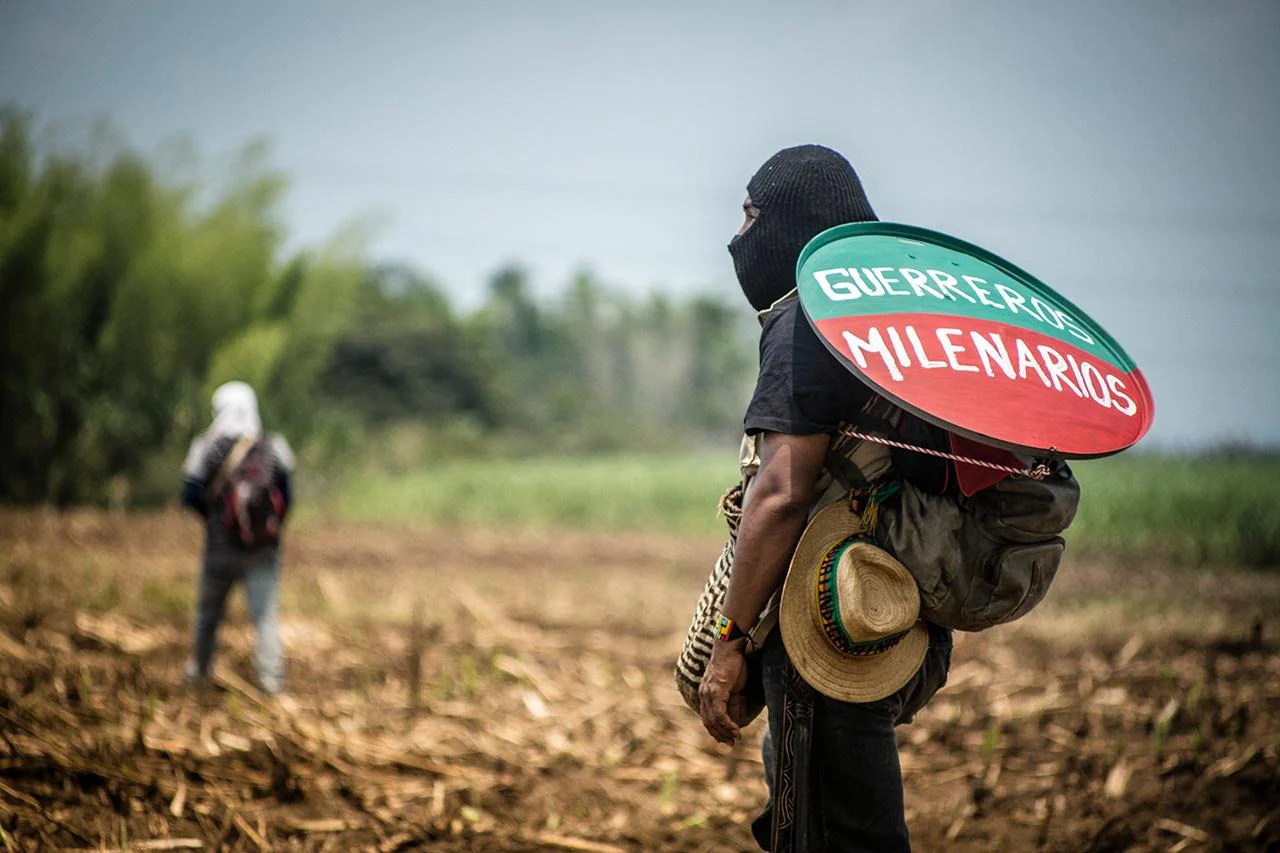
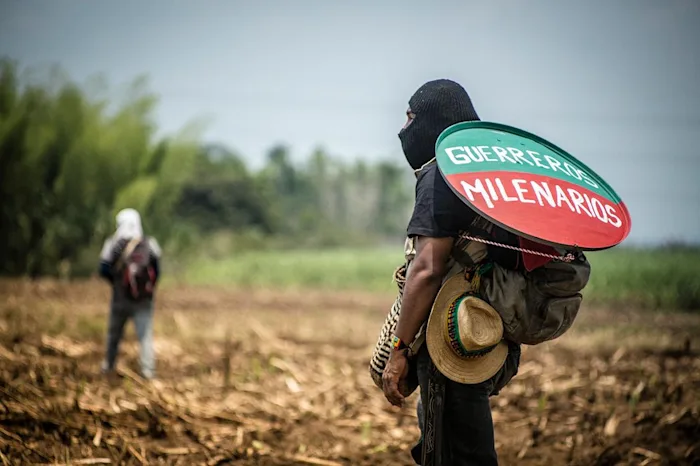
It’s not as if we already know everything. The heart is an occupied territory. The main offensive of power has been waged against it. Can’t you hear the cannons? Listen to the bombardments, the heavy artillery, the military tanks as they fire at the very center of the Nasa heart. Beyond their lead bullets, they also throw money into the equation. That’s why we insist that this peace of the government does not represent us, and does not resolve the situation. On the contrary, it will deepen neoliberalism. It will deepen the invasion. For them, the Nasa heart is an impediment. It’s the new theater of operations: this is why it gorgojea, it weakens.12 And when we realize this, we can say that we are going to heal it, that we are going to free it (desalambrarlo). It doesn’t get healed in books, as useful as they are. It doesn’t get healed on screens. What we have noticed is that it heals in the plantations, entering them not as an act of revenge but as a gesture of love for the mother who brought us here healthy one day, to enjoy the fruits of life. That is why it will be the voice of that mother who speaks to us. Who else? She alone pits her heart against the tanks, the planes, the artillery. Her voice is the deep river, and we have entered it.
Mother Earth is a living being, what they call a living superorganism. She feels everything, thinks everything, organizes everything. We, the humans, are just a stitch in the fabric of the great woven carrier bag (yaja) of the planet. We are, because other beings are. And yet other beings cease to be so that we may be. The capitalist system damages the fabric of life to the point of unbalancing the scales. It’s not that we wish to be the saviors of life — the Earth alone knows how to heal itself. The bare hills will reforest themselves if we leave them alone. Mother Earth would never fill the river basins with pine and eucalyptus plantations. Humans can choose to be predators, hindrances, or helpers.
The plantation owners — as the capitalists they are — will not listen. Goliath will want to hold on. They will prefer to hold onto their rage and squirm. It's not that Uma Kiwe won't talk to them, she does. But they have decided to send her to the nursing home, as certain sons are wont to do when they feel their mother is a bother. We have to confront them in the mingas and in the courts, there is no other way. However — in spite of all the damage they have caused, with deaths, injuries and mutilations — we do not hate them. We do not despise them. When they ask us for a glass of water, we will give it to them. As the Uwa people say: after all, if the bear is our brother, the white man is even more so. Someday these plantations will return to our hands and the water, air, and food that will spring from them will make their grandchildren happy.
For our part, since liberation is a long time coming, let's keep busy. What follows is what we are going to do. For now, we name it. We will give details about each point in due course. Each action, each step are strides toward achieving the dream of liberating Mother Earth:
We are going to enter more plantations. And in all of them we are going to cut and sow, to return joy to the Earth.
We are going to go on a minga throughout the territory. The territory is the world. Everywhere we go, we will be freeing the territory and freeing ourselves. Sharing, weaving.
We are going to hold a regional gathering (encuentro) of liberators.
We are going to make a school, a spiderweb of communication to weave beautifully: a minga of communication.
We are going to make a school for the pedagogy of liberation, summoning people, movements, and processes that walk in the same way in order to free ourselves together. And to weave in a beautiful way.
We are going to hold a meeting of liberators of Mother Earth, summoning people, movements, and processes in Abya Yala that walk along the same path. To share with one another, to weave together.
We are going to organize a food march (marcha de la comida). We are going to share the harvest of liberation with people cornered in the poor neighborhoods that capitalism has been creating in the cities.
One thing is clear. There are several things, but it is only one:
We are not going to leave the plantations. We are not going to settle for projects or anything other than the plantations we now occupy. This is an autonomous process of the communities following the points of struggle of the CRIC. We are accompanied by our cabildos. The liberation points are walking hand in hand with them. We are not going to let them disperse us. We don’t have external spokespeople, we [nosotras y nosotros] speak for ourselves. And we are going to make sure that no one takes advantage of this process. The sweat and the blisters, José’s wound, Milena's baby, Julia's pact, the one-eyed and mutilated, our comrades on trial, the dead and their families, speak clearly to us: no one sells out our struggle.
We are not in a rush. When the time comes to “negotiate,” it will be within the plantations and the only acceptable deal will be their freedom. On that day they will no longer be plantations, they will be Uma Kiwe.
The red and green flags accompany our struggle and tremble with excitement at each point of liberation. Don't you?
—Mother Earth Liberation Process Nasa people, northern Cauca, Colombia December 16, 2016
Images: Ariel Arango / Entrelazando
Notes
1. A fish native to the place that is currently called Colombia. (All footnotes have been added by the translator)↰
2. A minga is a form of collective labor indigenous to the Andes.↰
3. Bastones de mando translates directly into “staffs of authority.” These wooden staffs are held by Nasa indigenous authorities to signify their position within the community. The kiwe thegnas also carry wooden staffs to protect their community from armed groups (state and non-state), drug traffickers, and other actors that threaten their ability to exercise autonomy and self-determination. Kiwe thegnas literally translates from Nasa Yuwe to English as “caretaker of the land.” In Spanish and English, they are commonly referred to as the Guardia Indígena or Indigenous Guard. ↰
4. The sowing of the placenta and umbilical cord in the birthplace manifests an intimate connection with the territory for many communities throughout this region of Abya Yala. The reference to “sowing” in this context also relates to what non-Nasa people would call a burial. ↰
5. This paragraph enumerates various examples of violence, resistance, and creation against the Nasa indigenous people over time. For additional information, see “Sencillamente nasas” by Wiliam Ascue Fernández and “Entonces, ¡Hablamos!” by the CRIC. ↰
6. Terraje is a form of debt peonage. ↰
7. Nasa Pal literally translates to “Nasa Priest.” Here, they are referring to Álvaro Ulcué, a Nasa priest who was murdered in 1984 for struggling with the communities. ↰
8. Wët wët fxi'zenxi is a vital aspect of the Nasa indigenous people’s cosmovision. It is roughly translated to “the good life” in English or “buen vivir” in Spanish. For more on wët wët fxi'zenxi, see Almendra Quiguanás’ Entre la emancipación y la captura. ↰
9. This is a reference to the Zapatista caracoles.↰
10. A pacora is a large machete.↰
11. Desalambrar la tierra depende de desalambrar el corazón. The word desalambrar literally means “to remove barbed wire.”↰
12. For Nasa people, gorgojo is a plague that destroys corn from the inside. Gorgojear is the verb form of the plague. There is a saying in Nasa Yuwe — ūus çxika — which means gorgojo of the heart.↰